Growing onions on a feather in a greenhouse is beneficial at any time of the year, especially in winter. Of all types of greenery, this is the most productive crop. At minimum cost, you can get high yields. To start a business, it is enough to have a greenhouse and savings in the country to purchase planting material.
Content
Features of growing in a greenhouse
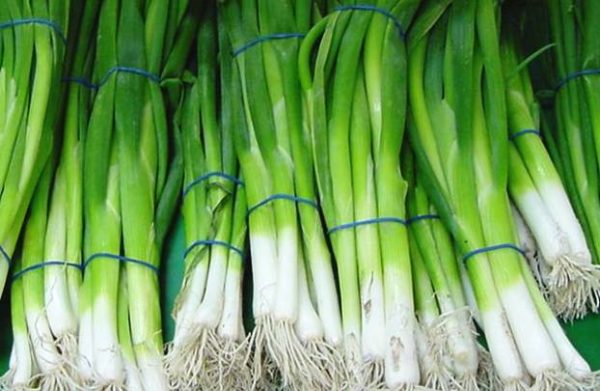
Growing onions is beneficial to do in winter. Demand for it is growing at this time, this is reflected in the purchase value. In the southern regions, onion distillation is cheaper, since the cost of heating and lighting is lower.
To open a small business for growing onions in 1-2 greenhouses, registration is not required. You can not hire labor. A medium and large greenhouse business requires registration, payment of taxes, accounting, and the employment of hired workers.
The funds spent on the construction and equipment of the greenhouse, the purchase of seed, fertilizers, pay off in an average of 6 months. To increase profitability, in addition to onions, no less popular dill, aromatic basil, and useful parsley are grown in the greenhouse.
The benefits of the greenhouse method
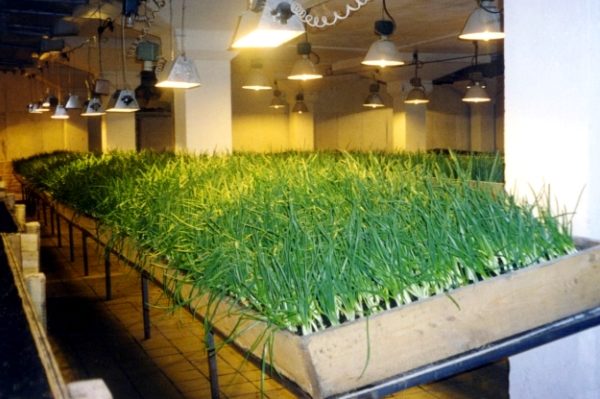
In sheltered soil, you can organize year-round forcing of the pen. This is true for home consumption and when creating a family business. Every 3 weeks from a square meter of the ridge, you can cut up to 5 kg of onions. This is possible with the proper organization of labor, the use of shelving, feeding.
The advantages of protected soil is that it is easier to create favorable conditions for the growth of this crop. Onion is a cold-resistant plant, demanding of light, soil fertility, moisture-loving. In a greenhouse, providing it with everything you need is easy.
Landing time
You can grow onions in closed ground several times. It takes about a month to distill one batch of onions. For an uninterrupted supply of greenery, the heads are planted every 2 weeks from October to April.
Preparatory work
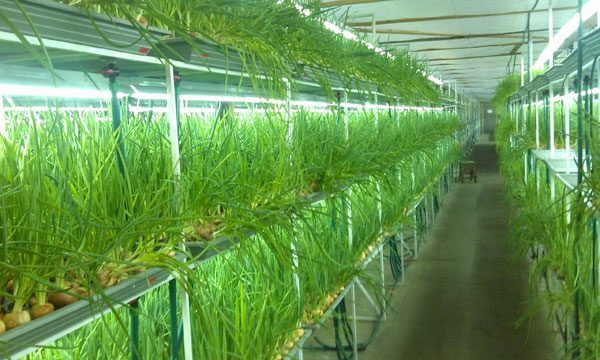
The space of the greenhouse is limited. Shelves are installed for the intensive use of each square meter of area. The multi-tiered cultivation of the feather saves space, increases the volume of the crop.
Buying shelving
Shelves can be made with your own hands from lumber or metal corners. It's easier to buy finished products, their cost will quickly pay off. It is recommended to purchase racks with a shelf width of about 35 cm.
It is easy to work with such designs:
- the soil warms up quickly;
- onions grow fast;
- easy to care for seedlings and cut the crop.
Installation of fixtures
In greenhouses where multi-tiered racks are installed, fixtures are mounted in each level. The installation of LED lamps (tapes) reduces energy costs. Recommended power of luminaires with LEDs is 25 watts.
In greenhouses, fluorescent lamps with a power of 15 to 58 watts can be used. At specialized point of sale, gardeners offer phytolamps. The spectrum of their radiation is close to the solar. If summer lighting is not required, then in winter greenhouses it is necessary.
Watering and heating
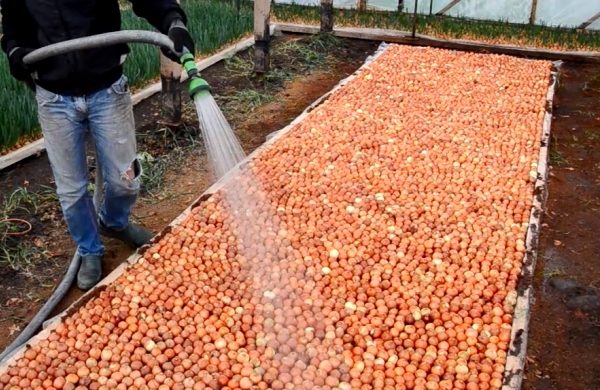
Irrigation requires warm, well-maintained water.Having spent money on a drip irrigation system, gardeners make their work easier and save water. To heat the room, they construct a heating system, it includes:
- heat source (boiler, stove, electric gas heater);
- pipe system.
What should be a greenhouse
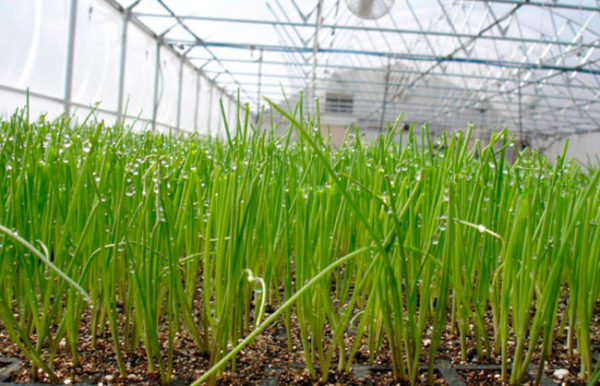
For the growth of any garden culture, it is necessary to create suitable conditions. To grow green onions in a greenhouse in winter, it is necessary to ensure optimal temperature and light conditions:
- air temperature during the day 18-20 ° C;
- at night it should not fall below 12-15 ° C;
- daylight hours of at least 12 hours.
To create such a microclimate, gardeners use two types of greenhouses:
- heated;
- unheated.
Cold unheated greenhouse
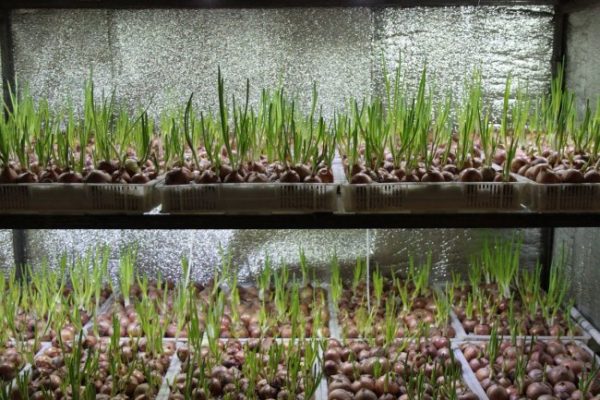
This type of greenhouse is used in early spring and autumn. The heating of the earth and air is carried out by the sun in the daytime. The basis of the structure is the frame. They make it from wooden blocks or a metal profile. As a coating use:
- glass;
- perennial film for greenhouses;
- polycarbonate.
These covering materials retain heat well at night, during the day they do not interfere with the passage of sunlight. There are various models of polycarbonate greenhouses on sale. They vary in size, shape, cost. You can collect them with your own hands. The cost will pay off quickly.
The frame is installed on the foundation. For unheated greenhouses, simple designs of timber in the form of a frame are suitable. In order for the greenhouse to serve for a long time, they acquire a coniferous timber. From the fungus, the surface is treated with antiseptics.
Heated greenhouse
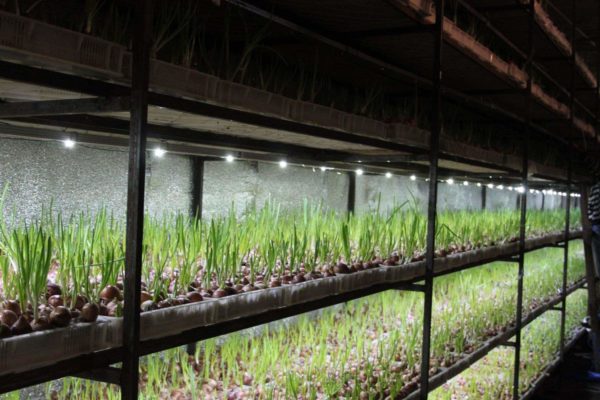
In winter, onions are grown on feathers in heated greenhouses. The construction is the same as that of unheated greenhouses:
- foundation;
- frame;
- coating.
In regions with cold winters, the foundation is made of jellied or made of concrete blocks to reduce heat loss.
Winter daylight hours are short, so light is applied to the greenhouse to create artificial lighting. To maintain heat, a heat source (boiler) is installed, pipes are mounted around the perimeter. In the greenhouse organize the supply of water from the well, well, water supply.
Growing onions on greens from seeds
Onions are grown in winter from seeds or from heads. Landing technology is different. In cold, unheated greenhouses, spring onions are grown from chernushka. It can be sown late fall (without soaking) or early spring.
Seed selection and preparation
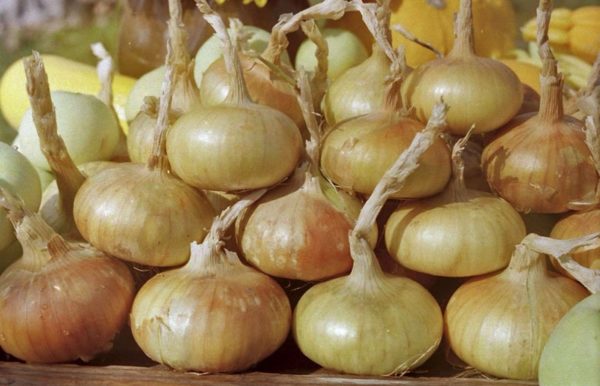
In greenhouses, varieties suitable for indoor use are grown, giving a gentle, tasty feather:
- onion-batun;
- shallot;
- onion slime;
- chives.
Spring seeds soak before landing. For convenience, they are poured into gauze bags. They are kept moist for 24 to 48 hours. Before sowing, they are slightly dried.
Landing procedure
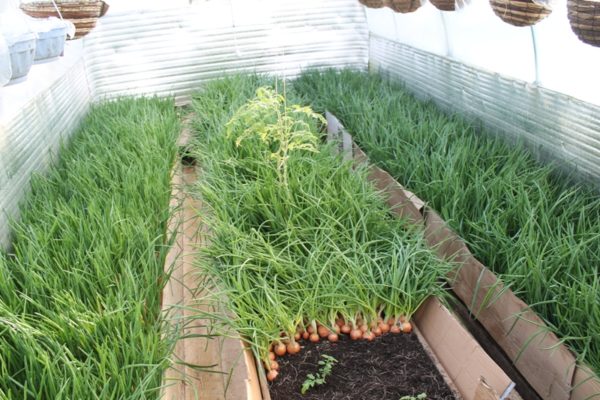
The soil a day before sowing is well moistened, grooves are made the next day. They are placed at a distance of 20 cm from each other. Seeds are laid out in 2-3 cm increments and covered with a layer of peat or humus. Depth 2.5 cm.
Bulb planting
In the greenhouse for forcing feathers in the winter planted multiglanti onion varieties. They are more productive, give more greenery. When selecting seed material, bulbs with a diameter of about 4 cm are selected.
To understand how many rudiments are in a variety, it is necessary to cut off the upper part of the bulb and calculate the number of nests. They are clearly visible, they are green or pale yellow. The best varieties of onions on the feather:
- Bessonovsky;
- Arzamas;
- Strigunovsky;
- Chernihiv
Before start landing, bulbs are preparing. It takes a few days. First they are heated at a temperature of 40 ° C. Then they are soaked for several hours in water heated to 50 ° C. Each bulb is cut off the neck by the shoulders before being lowered into the water.After that, planting material is kept for 3 days in a damp cloth.
Soil preparation
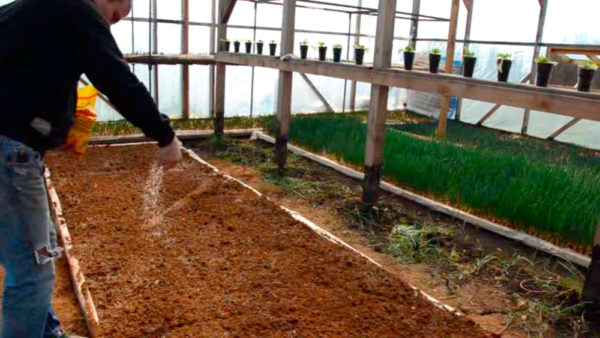
Growing onions in winter in a greenhouse begins with soil preparation. It can be used repeatedly, at least 3-4 times. The substrate can be prepared on the basis of garden land or use small sawdust.
On 1 m² of soil fertilizers are applied:
- granules of superphosphate 30 g;
- crystals of sodium chloride 15 g;
- compost 8-10 kg.
Ash and granules of ammonium nitrate are added if sawdust is used as a substrate. They are scattered on top. Ash is a deoxidizer and a supplier of trace elements, nitrate nourishes the bulbs with nitrogen. Other dressings are not needed.
Growing technology
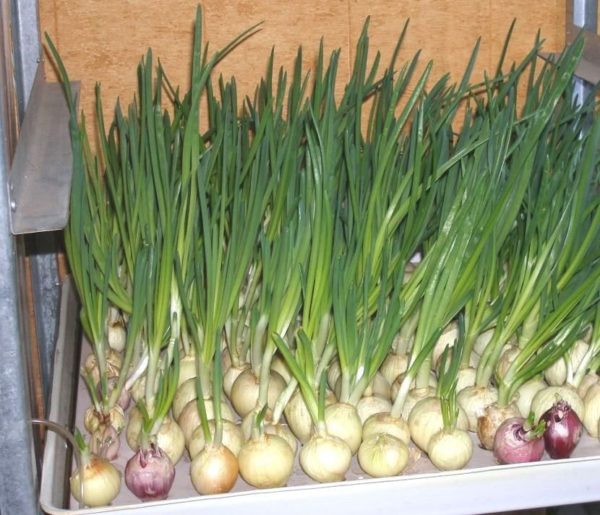
There are different technologies for growing green onions in a greenhouse in winter. Some suggest the use of land (pavement, tape), others do not (hydroponics, mats).
Bridge way
This method of growing onions on greens saves space in the greenhouse, reduces labor and time costs, and is especially effective when using shelving. Bulbs are stuck in a fertile substrate, placing them close.
Tape method
For planting onion heads on a feather (winter, spring) use the tape method. For its implementation:
- the ridge is leveled with a rake;
- outline furrows, maintaining an interval of 20 cm;
- stick in onion sets in 3 cm increments.
Hydroponics
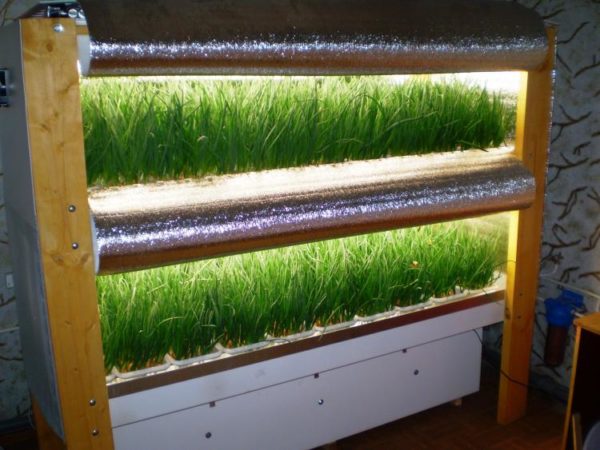
When implementing this method, a fertile substrate for onions is not required. To plant a seed you must have:
- water tank 40 x 80 cm in size, 20 cm high;
- cover with holes for the heads;
- compressor;
- heater.
At the stage of formation of the root system in the bulbs, the water is heated to 20 ° C. Later it is raised to 25 ° C to stimulate pen growth. The compressor is turned on for 6-12 hours.
The water is taken distilled, rain or tap, purified using a filter. Hydroponic fertilizer is added to it. Buy ready-made (POKON. FloraDuo Bloom, Greenworld Spezialdunger Hydrokultur) or do it yourself.
There are several recipes for preparing fertilizers for hydroponics:
- Gerik's solution;
- Hoagland's solution;
- Ellis solution.
Growing on mats
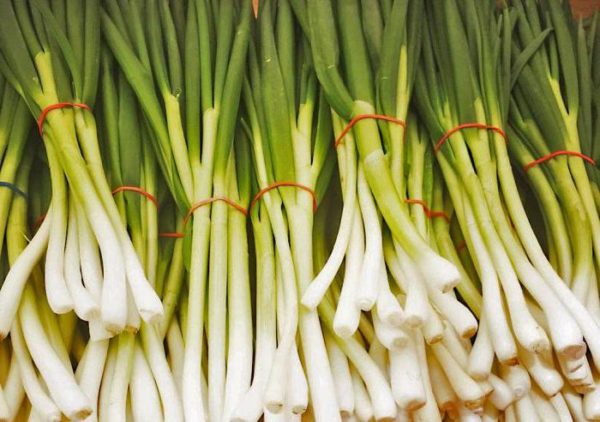
On sale there are special mats for greenhouses, they are first impregnated with a solution of fertilizers, and then the seeds are planted. Fit the heads tightly. The first 10 days there is a build-up of roots. At this time, the mats are covered with a cloth, the temperature is kept low.
After 10 days, the tissue is removed, the temperature is raised to 25 ° C. With the help of artificial and natural light, the culture is provided with 12 hours of daylight. Mats are watered with a solution of fertilizers.
Onion Care
Caring for onions in a covered ground (greenhouse) is not difficult. The main activities are as follows:
- the first watering is carried out after planting;
- until the end of the root formation process, maintain an air temperature of 20 ° C;
- 14 days after planting, watered with a solution of manganese to prevent fungal diseases;
- conduct inspection, remove rotten heads, and then increase the air temperature to 23 ° C.
The room is regularly ventilated. Watering is carried out 1 time per week.
Sales and sales of onions
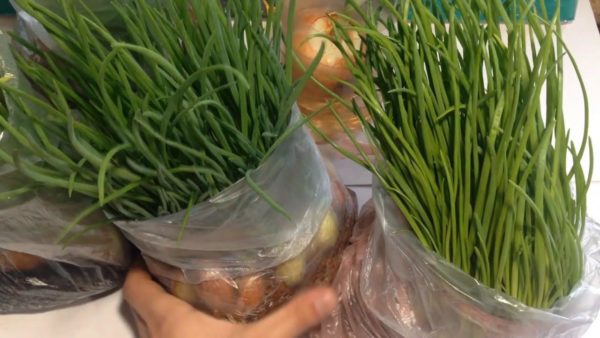
I begin to engage in the production of green onions after preliminary calculations. Draw up a business plan that takes into account all the costs of acquiring seed material, water, light, heat.
The owner of the greenhouse needs to register as a private entrepreneur in order to be able to sell products:
- at wholesale bases;
- in their stores;
- On the market.
Pen is a perishable product, therefore it is advantageous to conclude supply contracts with the owners of outlets. In this case, it is easy to plan the distillation of onions for the delivery dates specified in the contract.
The competition in the market is high, therefore, they are first determined with sales markets, then they invest in production.
findings
It is most beneficial to grow onions on a feather in the summer. Electricity and heating costs are reduced. According to experts, the profitability of summer onion distillation is 50%, in winter - 30%.

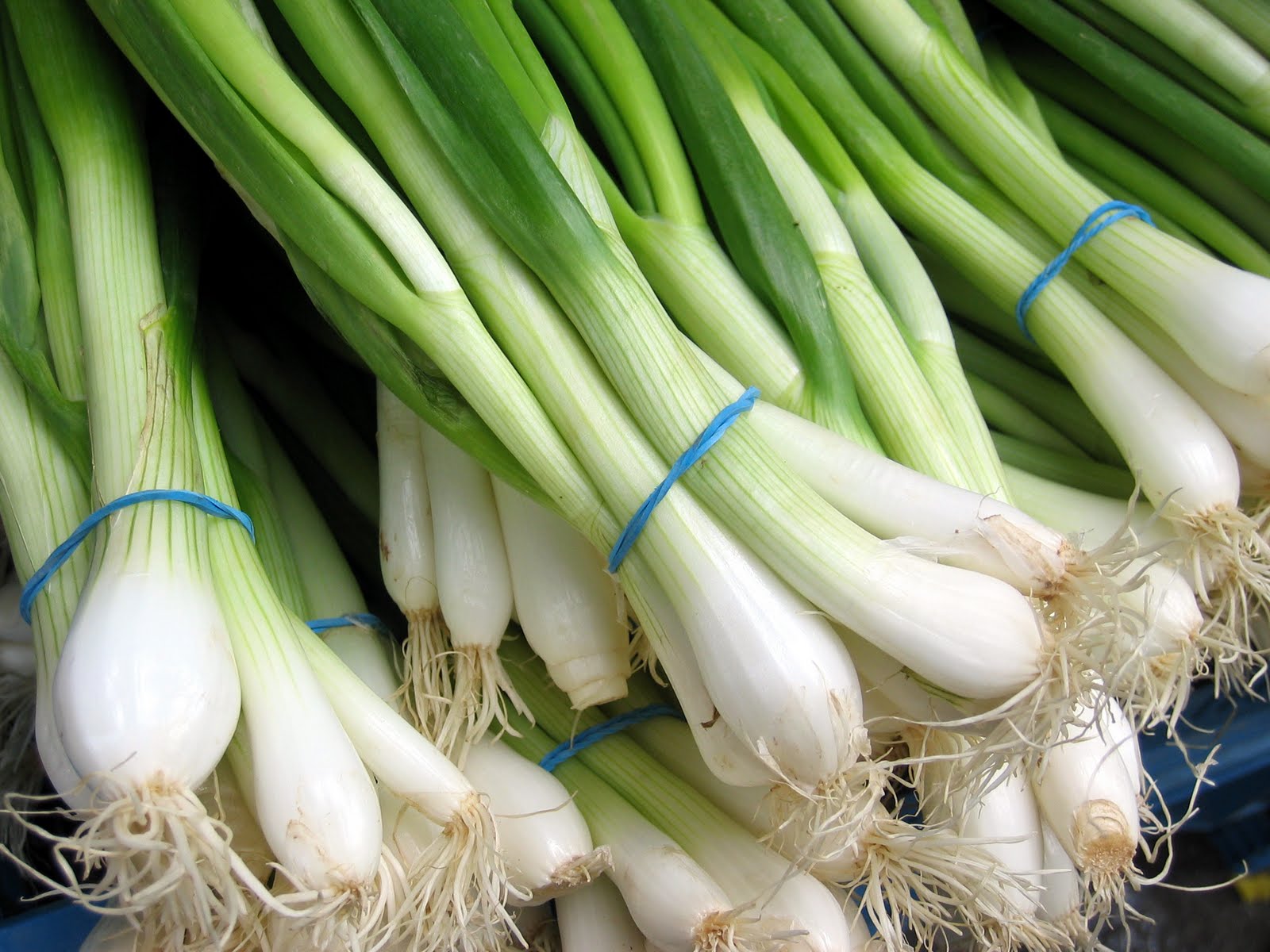 Growing onions on a feather in a greenhouse in winter
Growing onions on a feather in a greenhouse in winter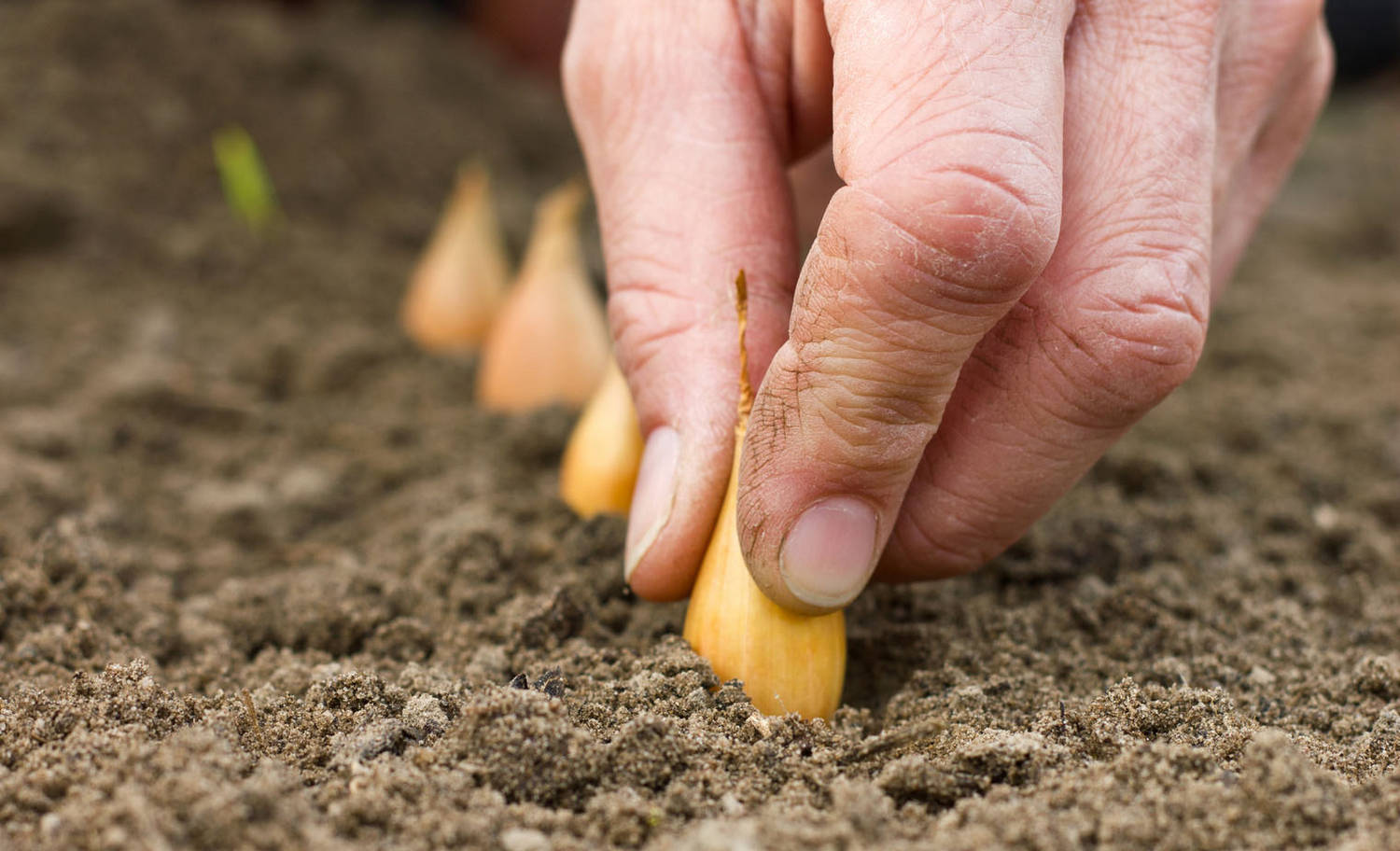 Planting onions in winter in the open ground
Planting onions in winter in the open ground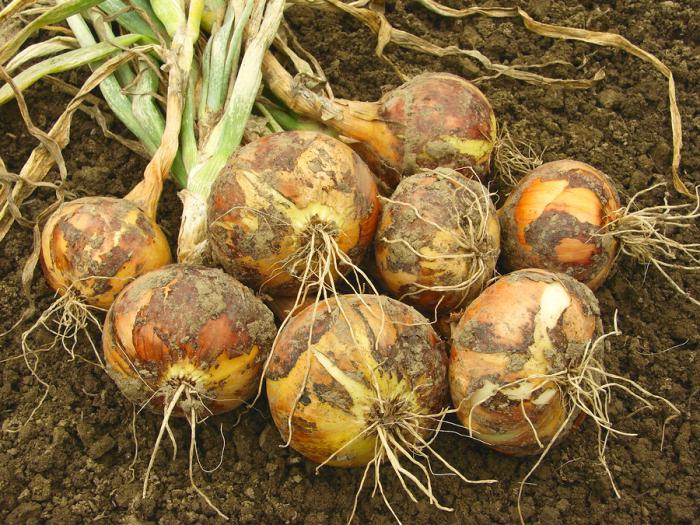 How to feed onions so that the bulbs beat large
How to feed onions so that the bulbs beat large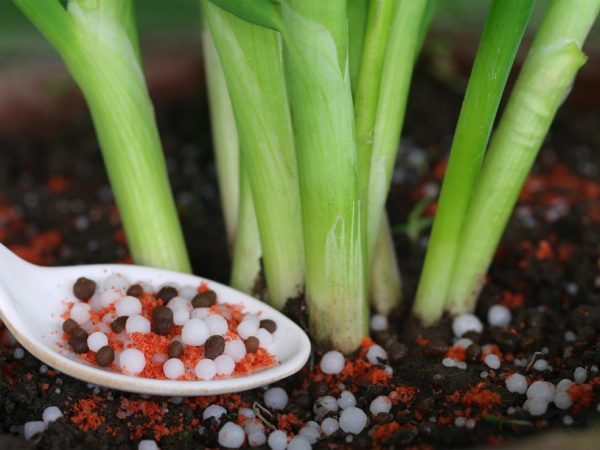 How to feed onions in spring and summer to get a good harvest?
How to feed onions in spring and summer to get a good harvest?